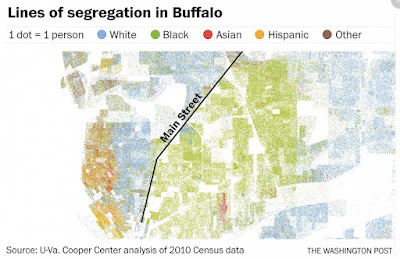“Buffalo is a powder keg,” said Franchelle Parker, executive director of Open Buffalo. “We can’t talk about what happened on Saturday as one isolated event. Buffalo has been a breeding ground for this type of situation to occur.”Has so little changed since the 1960s? Apparently not. The massacre in Buffalo took place two miles from my childhood home. Not that, as a young person, I hardly ever ventured over there -- into east of Main Street, into darkest Buffalo where Black Buffalonians were corralled.
Since the 1930s, Black neighborhoods have been ranked as financially unstable to dissuade lenders from approving Black homeowners for loans. This meant Black homeowners were subject to different procedures when purchasing a home, which restricted the flow of capital into Black neighborhoods and prohibited Black homeowners from buying in white neighborhoods—reinforcing segregation.
The lack of access to loans also made it more difficult for Black people to open businesses and build wealth, sparking a downward spiral of disinvestment. Today, the impacts of segregation are clearly visible in the resources available in the city of Buffalo. Of the five major employment centers in Erie County, only one is located within the city of Buffalo, and there are 51 census block groups that have limited access to supermarkets. Every single one is located east of Main Street.
Even in my insulated white high school, I knew something should be done to break the pattern; I demonstrated with a fair housing outfit. It seems to still be operating, still a necessary cog in Buffalo's nonprofit industrial complex.
In those days there was hope of a sort. There was the civil rights movement in the South. There were somewhat organized community demands. There was the communal outpouring of frustration/rebellion in 1967.
By then I'd escaped to California. White Buffalo wasn't any place for a lefty lesbian feminist then -- or probably now.
The people east of Main Street have not escaped, nor can they, nor perhaps do they wish to. I've even known people who moved there for refuge -- where else in the 1990s could you find a house, however dilapidated, for under $10K? Maybe in some burned out section of Detroit -- there's a pattern here.
I just pray that the folks east of Main Street can leverage some of the attention the murderous white man with an AR-15 has brought to their community for some improvement, some hope.


No comments:
Post a Comment